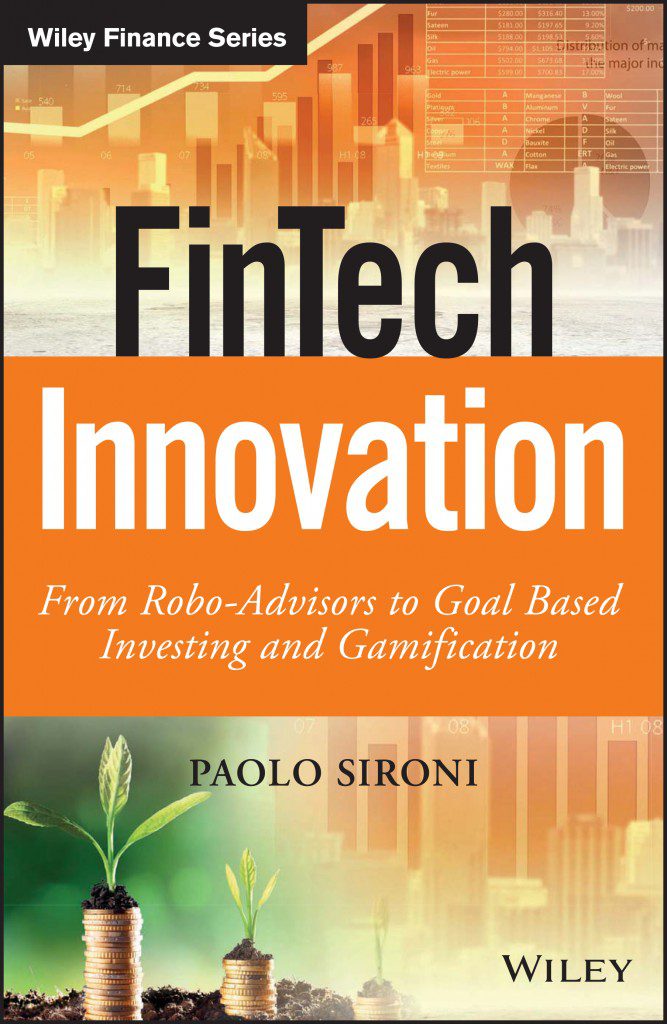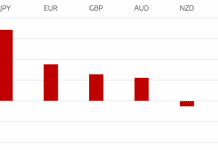
FinTech Innovation Book by Paolo Sironi
A survival guide to WealthTech
Business models are changing in profound ways, and the impact of these changes is reaching further than many expected. Keeping pace has become a survival skill for financial advisors globally. Social media, big data analytics and digital technologies are disrupting aspect of the wealth management industry that have been taken for granted for millennia.
Practitioners need to examine this revolution in detail in order to understand the mechanisms at work. In FinTech Innovation, Paolo Sironi presents an analysis of the tectonic shifts, as well as the more subtle changes and offers clear insight into the implications of this transformation.
The book lucidly describes the rise of financial technology, illustrating the massive changes already underway to transform the wealth management into an industry that is much more efficient and client-centric. The book also provides insight into the changes that are yet to come.
In FinTech Innovation Paolo Sironi examines the rise of financial technology and its growing impact on the global banking industry. Wealth managers are standing at the epicenter of a tectonic shift, as the balance of power between offering and demand undergoes a dramatic upheaval. Regulators are pushing toward a ‘constrained offering’ norm while private clients and independent advisors demand a more proactive role; practitioners need examine this banking evolution in detail to understand the mechanisms at work. This book presents analysis of the current shift and offers clear insight into what happens when established economic interests collide with social transformation. Business models are changing in profound ways, and the impact reaches further than many expect; the democratization of banking is revolutionizing the wealth management industry toward more efficient and client-centric advisory processes, and keeping pace with these changes has become a survival skill for financial advisors around the world.
Social media, big data analytics and digital technology are disrupting the banking industry, which many have taken for granted as set in stone. This book shatters that assumption by illustrating the massive changes already underway, and provides thought leader insight into the changes yet to come.
- Examine the depth and breadth of financial technology
- Learn how regulations are driving changing business models
- Discover why investors may become the price-makers
- Understand the forces at work behind the rise of FinTech
Information asymmetry has dominated the banking industry for centuries, keeping the bank/investor liability neatly aligned—but this is changing, and understanding and preparing for the repercussions must be a top priority for wealth managers everywhere. Financial Innovation shows you where the bar is being re-set and gives you the insight you need to keep up.
In FinTech Innovation readers discover:
- The technological forces at work behind the rise of FinTech
- Why investors may become the price-makers
- How regulations are driving changing business models
Information asymmetry has dominated the wealth management industry for centuries, keeping the manager/investor liability neatly in balance—but this is changing rapidly, and understanding and preparing for the repercussions must be a top priority for wealth managers everywhere.
Aimed at financial advisors and planners, wealth managers, financial technology companies, as well as bankers and consultants FinTech Innovation provides the readers with insight required to succeed and thrive.

Table of Contents
Preface xiii
Acknowledgments xix
About the Author xxi
PART ONE Personalize Personal Finance
CHAPTER 1 The Theory of Innovation: From Robo-Advisors to Goal Based Investing and Gamification 3
1.1 Introduction 3
1.2 A vibrant FinTech ecosystem 5
1.3 Some definitions, ladies and gentlemen 8
1.4 Personalization is king 9
1.5 The theory of innovation 11
1.6 My Robo-Advisor is an iPod 13
1.7 What incumbents should consider when thinking about FinTech innovation 15
1.8 Conclusions 17
PART TWO Automated Long-Term Investing Means Robo-Technology
CHAPTER 2 Robo-Advisors: Neither Robots Nor Advisors 21
2.1 Introduction 21
2.2 What is a Robo-Advisor? 22
2.3 Automated digital businesses for underserved markets 25
2.4 Passive investment management with ETFs 26
2.5 Algorithms of automated portfolio rebalancing 29
2.6 Personalized decision-making, individual goals, and behaviour 30
2.7 Single minded businesses 31
2.8 Principles of tax-loss harvesting 33
2.9 Conclusions 36
CHAPTER 3 The Transformation of the Supply-Side 39
3.1 Introduction 39
3.2 The investment management supply-demand chain 40
3.3 How intermediaries make money 42
3.4 Issuers of direct claims (debt owners) 44
3.5 The institutionalization of the private banking relationship 45
3.6 The digital financial advisor 51
3.7 Asset management is being disintermediated 54
3.8 ETF providers and the Pyrrhic victory 57
3.9 Vertically integrated solutions challenge traditional platforms 59
3.10 Conclusions 60
CHAPTER 4 Social and Technology Mega Trends Shape a New Family of Taxable Investors 61
4.1 Introduction 61
4.2 Generational shift (X, Y, Z, and HENRYs) 62
4.3 About transparency, simplicity, and trust 65
4.4 The cognitive era 67
4.5 Conclusions 70
CHAPTER 5 The Industry’s Dilemma and the Future of Digital Advice 71
5.1 Introduction 71
5.2 Wealth management firms: Go digital or die 72
5.3 Asset management firms: Less passive, more active 75
5.4 Robo-Platforms: Less transactions, more portfolios 76
5.5 Digital-Advisors: Empowered customization 77
5.6 Robo-Advisors: Be human, be virtual, take care of retirement 79
5.7 Conclusions: Clients take centre stage, at last 81
PART THREE Goal Based Investing is the Spirit of the Industry
CHAPTER 6 The Principles of Goal Based Investing: Personalize the Investment Experience 85
6.1 Introduction 85
6.2 Foundations of Goal Based Investing 89
6.3 About personal needs, goals, and risks 91
6.4 Goal Based Investing process 96
6.5 What changes in portfolio modelling 97
6.6 Personal values 100
6.7 Goal elicitation 100
6.8 Goal priority 102
6.9 Time horizons 102
6.10 Risk tolerance 103
6.11 Reporting goal-centric performance 105
6.12 Conclusions 108
CHAPTER 7 The Investment Journey: From Model Asset Allocations to Goal Based Operational Portfolios 109
7.1 Introduction 109
7.2 Main traits of Modern Portfolio Theory 113
7.2.1 Asset diversification and efficient frontier 114
7.2.2 The Mean-Variance model portfolio 117
7.2.3 Final remarks about Mean-Variance 118
7.3 Main traits of Black-Litterman 118
7.3.1 The equilibrium market portfolio 119
7.3.2 Embedding professional views 121
7.3.3 The Black-Litterman optimal portfolio 122
7.3.4 Final remarks on Black-Litterman 122
7.4 Mean-Variance and mental accounts 123
7.4.1 Final remarks on Mean-variance and Mental Account 123
7.5 Main traits of Probabilistic Scenario Optimization 124
7.5.1 The PSO process 124
7.5.2 The investor’s risk and return profile 126
7.5.3 Generation of scenarios and scenario paths 128
7.5.4 Stochastic simulation of products and portfolios over time 128
7.5.5 Potential and admissible portfolios: Allocation constraints 129
7.5.6 Adequate portfolios: Risk adequacy 130
7.5.7 Objective function: Probability maximization 131
7.5.8 Final remarks on PSO 135
7.5.9 Conclusions 135
CHAPTER 8 Goal Based Investing and Gamification 137
8.1 Introduction 137
8.2 Principles of Gamification 138
8.3 Gamification of wealth management 140
8.4 The mechanics of games 141
8.5 Conclusions 143
Concluding Remarks 145
Bibliography 147
Index 151
About the author:
Paolo Sironi is a global thought leader for Wealth Management and Investment Analytics at IBM, where he is responsible for promoting quantitative methods, Goal Based Investing (GBI) and digital solutions for financial advisory. His expertise combines financial services and technology and spans over a number of areas, including wealth management, asset management, risk management and FinTech innovation.
Prior to IBM, he founded a FinTech startup that provided GBI portfolios to wealth managers. This venture subsequently became a part of IBM following the acquisition of funding partner Algorithmics, a world leader of risk management and investment analytics. Paolo possesses a decade-long risk management expertise; he was previously head of market and counterparty risk modeling at Banca Intesa Sanpaolo. He is the author of Modern Portfolio Management: From Markowitz to Probabilistic Scenario Optimisation, and contributing author to The FINTECH Book.
HedgeThink.com is the fund industry’s leading news, research and analysis source for individual and institutional accredited investors and professionals








































